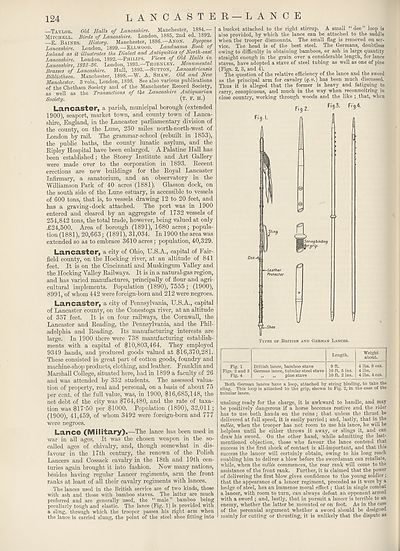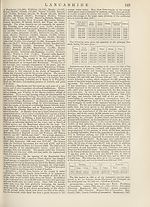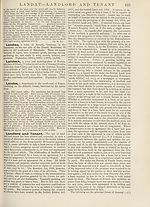New volumes of the Encyclopædia Britannica > Volume 30, K-MOR
(148) Page 124
Download files
Complete book:
Individual page:
Thumbnail gallery: Grid view | List view

124
LANCASTER — LANCE
—Taylob. Old Halls of Lancashire. Manchester, 1884.
Mitchell. Birds of Lancashire. London, 1885, 2nd ed. 1892.
—E. Baines. History. Manchester, 1886. Anon. Byegone
Lancashire. London, 1899. —Ellwood. Landnama Book of
Iceland as it illustrates the Dialect and Antiquities of North-east
Lancashire. London, 1892.—Philips. Views of Old Halls m
Lancashire, 1822-26. London, 1893.—Thorn ley. Monumental
Brasses of Lancashire. Hull, 1893.—Sutton, Lancastrians
Bibliotheca. Manchester, 1898.—W. A. Shaw. Old and New
Manchester. 3 vols., London, 1898. See also various publications
of the Chetham Society and of the Manchester Record Society,
as well as the Transactions of the Lancashire Antiquarian
Society. (T- H-)
Lancaster1, a parish, municipal borough (extended
1900), seaport, market town, and county town of Lanca¬
shire, England, in the Lancaster parliamentary division of
the county, on the Lune, 230 miles north-north-west of
London by rail. The grammar-school (rebuilt in 1853),
the public baths, the county lunatic asylum, and the
Eipley Hospital have been enlarged. A Palatine Hall has
been established; the Storey Institute and Art Gallery
were made over to the corporation in 1893. Recent
erections are new buildings for the Royal Lancaster
Infirmary, a sanatorium, and an observatory in the
Williamson Park of 40 acres (1881). Glasson dock, on
the south side of the Lune estuary, is accessible to vessels
of 600 tons, that is, to vessels drawing 12 to 20 feet, and
has a graving-dock attached. The port was in 1900
entered and cleared by an aggregate of 1732 vessels of
254,842 tons, the total trade, however, being valued at only
£24,500. Area of borough (1891), 1680 acres; popula¬
tion (1881), 20,663; (1891), 31,034. In 1900 the area was
extended so as to embrace 3610 acres; population, 40,329.
Lancaster, a city of Ohio, U.S.A., capital of Fair-
field county, on the Hocking river, at an altitude of 841
feet. It is on the Cincinnati and Muskingum Valley and
the Hocking Valley Railways. It is in a natural-gas region,
and has varied manufactures, principally of flour and agri¬
cultural implements. Population (1890), 7555; (1900),
8991, of whom 442 were foreign-born and 212 were negroes.
Lancaster, a city of Pennsylvania, U.S.A., capital
of Lancaster county, on the Conestoga river, at an altitude
of 357 feet. It is on four railways, the Cornwall, the
Lancaster and Reading, the Pennsylvania, and the Phil¬
adelphia and Reading. Its manufacturing interests are
large. In 1900 there were 738 manufacturing establish¬
ments with a capital of $10,803,464. They employed
9349 hands, and produced goods valued at $16,370,281.
These consisted in great part of cotton goods, foundry and
machine-shop products, clothing, and leather. Franklin and
Marshall College, situated here, had in 1899 a faculty of 26
and was attended by 332 students. The assessed valua¬
tion of property, real and personal, on a basis of about 75
per cent, of the full value, was, in 1900, $16,685,148, the
net debt of the city was $764,480, and the rate of taxa¬
tion was $17‘50 per $1000. Population (1890), 32,011 ;
(1900), 41,459, of whom 3492 were foreign-born and 777
were negroes.
Lance (Military).—The lance has been used in
war in all ages. It was the chosen weapon in the so-
called ages of chivalry, and, though somewhat in dis¬
favour in the 17th century, the renown of the Polish
Lancers and Cossack cavalry in the 18th and 19th cen¬
turies again brought it into fashion. Now many nations,
besides having regular Lancer regiments, arm the front
ranks at least of all their cavalry regiments with lances.
The lances used in the British service are of two kinds, those
with ash and those with bamboo staves. The latter are much
preferred and are generally used, the “male” bamboo being
peculiarly tough and elastic. The lance (Fig. 1) is provided with
a sling, through which the trooper passes his right arm when
the lance is carried slung, the point of the steel shoe fitting into
a bucket attached to the right stirrup. A small “dee” loop is
also provided, by which the lance can be attached to the saddle
when the trooper dismounts. The small flag is removed on ser¬
vice. The head is of the best steel. The Germans, doubtless
owing to difficulty in obtaining bamboos, or ash in large quantity
straight enough in the grain over a considerable length, for lance
staves, have adopted a stave of steel tubing as well as one of pine
(Figs. 2, 3, and 4).
The question of the relative efficiency of the lance and the sword
as the principal arm for cavalry (q.v.) has been much discussed.
Thus it is alleged that the former is heavy and fatiguing to
carry, conspicuous, and much in the way when reconnoitring in
close country, working through woods and the like ; that, when
Fig. 1
Figs. 2 and 3
Fig. 4
British lance, bamboo stave
German lance, tubular steel stave
,, ,, pine stave
Length.
9 ft.
10 ft. 5 ins.
10 ft. 2 ins.
Weight
about.
4 lbs. 8 ozs.
4 lbs.
4 lbs. 4 ozs.
Both German lances have a loop, attached by string binding, to take the
sling. This loop is attached to the grip, shown in Fig. 2, in the case of the
tubular lance.
unslung ready for the charge, it is awkward to handle, and may
be positively dangerous if a horse becomes restive and the rider
has to use both hands on the reins ; that unless the thrust be
delivered at full speed, it is easily parried; and, lastly, that in the
mtUe, when the trooper has not room to use his lance, he will be
helpless until he either throws it away, or slings it, and can
draw his sword. On the other hand, while admitting the last-
mentioned objection, those who favour the lance contend that
success in the first shock of contact is all-important, and that this
success the lancer will certainly obtain, owing to his long reach
enabling him to deliver a blow before the swordsman can retaliate,
while, when the rneUe commences, the rear rank will come to the
assistance of the front rank. Further, it is claimed that the power
of delivering the first blow gives confidence to the' young soldier ;
that the appearance of a lancer regiment, preceded as it were by a
hedge of steel, has an immense moral effect; that in single combat
a lancer, with room to turn, can always defeat an opponent armed
with a sword ; and, lastly, that in pursuit a lancer is terrible to an
enemy, whether the latter be mounted or on foot. As in the case
of the perennial argument whether a sword should be designed
mainly for cutting or thrusting, it is unlikely that the dispute as
\
LANCASTER — LANCE
—Taylob. Old Halls of Lancashire. Manchester, 1884.
Mitchell. Birds of Lancashire. London, 1885, 2nd ed. 1892.
—E. Baines. History. Manchester, 1886. Anon. Byegone
Lancashire. London, 1899. —Ellwood. Landnama Book of
Iceland as it illustrates the Dialect and Antiquities of North-east
Lancashire. London, 1892.—Philips. Views of Old Halls m
Lancashire, 1822-26. London, 1893.—Thorn ley. Monumental
Brasses of Lancashire. Hull, 1893.—Sutton, Lancastrians
Bibliotheca. Manchester, 1898.—W. A. Shaw. Old and New
Manchester. 3 vols., London, 1898. See also various publications
of the Chetham Society and of the Manchester Record Society,
as well as the Transactions of the Lancashire Antiquarian
Society. (T- H-)
Lancaster1, a parish, municipal borough (extended
1900), seaport, market town, and county town of Lanca¬
shire, England, in the Lancaster parliamentary division of
the county, on the Lune, 230 miles north-north-west of
London by rail. The grammar-school (rebuilt in 1853),
the public baths, the county lunatic asylum, and the
Eipley Hospital have been enlarged. A Palatine Hall has
been established; the Storey Institute and Art Gallery
were made over to the corporation in 1893. Recent
erections are new buildings for the Royal Lancaster
Infirmary, a sanatorium, and an observatory in the
Williamson Park of 40 acres (1881). Glasson dock, on
the south side of the Lune estuary, is accessible to vessels
of 600 tons, that is, to vessels drawing 12 to 20 feet, and
has a graving-dock attached. The port was in 1900
entered and cleared by an aggregate of 1732 vessels of
254,842 tons, the total trade, however, being valued at only
£24,500. Area of borough (1891), 1680 acres; popula¬
tion (1881), 20,663; (1891), 31,034. In 1900 the area was
extended so as to embrace 3610 acres; population, 40,329.
Lancaster, a city of Ohio, U.S.A., capital of Fair-
field county, on the Hocking river, at an altitude of 841
feet. It is on the Cincinnati and Muskingum Valley and
the Hocking Valley Railways. It is in a natural-gas region,
and has varied manufactures, principally of flour and agri¬
cultural implements. Population (1890), 7555; (1900),
8991, of whom 442 were foreign-born and 212 were negroes.
Lancaster, a city of Pennsylvania, U.S.A., capital
of Lancaster county, on the Conestoga river, at an altitude
of 357 feet. It is on four railways, the Cornwall, the
Lancaster and Reading, the Pennsylvania, and the Phil¬
adelphia and Reading. Its manufacturing interests are
large. In 1900 there were 738 manufacturing establish¬
ments with a capital of $10,803,464. They employed
9349 hands, and produced goods valued at $16,370,281.
These consisted in great part of cotton goods, foundry and
machine-shop products, clothing, and leather. Franklin and
Marshall College, situated here, had in 1899 a faculty of 26
and was attended by 332 students. The assessed valua¬
tion of property, real and personal, on a basis of about 75
per cent, of the full value, was, in 1900, $16,685,148, the
net debt of the city was $764,480, and the rate of taxa¬
tion was $17‘50 per $1000. Population (1890), 32,011 ;
(1900), 41,459, of whom 3492 were foreign-born and 777
were negroes.
Lance (Military).—The lance has been used in
war in all ages. It was the chosen weapon in the so-
called ages of chivalry, and, though somewhat in dis¬
favour in the 17th century, the renown of the Polish
Lancers and Cossack cavalry in the 18th and 19th cen¬
turies again brought it into fashion. Now many nations,
besides having regular Lancer regiments, arm the front
ranks at least of all their cavalry regiments with lances.
The lances used in the British service are of two kinds, those
with ash and those with bamboo staves. The latter are much
preferred and are generally used, the “male” bamboo being
peculiarly tough and elastic. The lance (Fig. 1) is provided with
a sling, through which the trooper passes his right arm when
the lance is carried slung, the point of the steel shoe fitting into
a bucket attached to the right stirrup. A small “dee” loop is
also provided, by which the lance can be attached to the saddle
when the trooper dismounts. The small flag is removed on ser¬
vice. The head is of the best steel. The Germans, doubtless
owing to difficulty in obtaining bamboos, or ash in large quantity
straight enough in the grain over a considerable length, for lance
staves, have adopted a stave of steel tubing as well as one of pine
(Figs. 2, 3, and 4).
The question of the relative efficiency of the lance and the sword
as the principal arm for cavalry (q.v.) has been much discussed.
Thus it is alleged that the former is heavy and fatiguing to
carry, conspicuous, and much in the way when reconnoitring in
close country, working through woods and the like ; that, when
Fig. 1
Figs. 2 and 3
Fig. 4
British lance, bamboo stave
German lance, tubular steel stave
,, ,, pine stave
Length.
9 ft.
10 ft. 5 ins.
10 ft. 2 ins.
Weight
about.
4 lbs. 8 ozs.
4 lbs.
4 lbs. 4 ozs.
Both German lances have a loop, attached by string binding, to take the
sling. This loop is attached to the grip, shown in Fig. 2, in the case of the
tubular lance.
unslung ready for the charge, it is awkward to handle, and may
be positively dangerous if a horse becomes restive and the rider
has to use both hands on the reins ; that unless the thrust be
delivered at full speed, it is easily parried; and, lastly, that in the
mtUe, when the trooper has not room to use his lance, he will be
helpless until he either throws it away, or slings it, and can
draw his sword. On the other hand, while admitting the last-
mentioned objection, those who favour the lance contend that
success in the first shock of contact is all-important, and that this
success the lancer will certainly obtain, owing to his long reach
enabling him to deliver a blow before the swordsman can retaliate,
while, when the rneUe commences, the rear rank will come to the
assistance of the front rank. Further, it is claimed that the power
of delivering the first blow gives confidence to the' young soldier ;
that the appearance of a lancer regiment, preceded as it were by a
hedge of steel, has an immense moral effect; that in single combat
a lancer, with room to turn, can always defeat an opponent armed
with a sword ; and, lastly, that in pursuit a lancer is terrible to an
enemy, whether the latter be mounted or on foot. As in the case
of the perennial argument whether a sword should be designed
mainly for cutting or thrusting, it is unlikely that the dispute as
\
Set display mode to:
![]() Universal Viewer |
Universal Viewer | ![]() Mirador |
Large image | Transcription
Mirador |
Large image | Transcription
Images and transcriptions on this page, including medium image downloads, may be used under the Creative Commons Attribution 4.0 International Licence unless otherwise stated. ![]()
| Encyclopaedia Britannica > New volumes of the Encyclopædia Britannica > Volume 30, K-MOR > (148) Page 124 |
|---|
| Permanent URL | https://digital.nls.uk/193569425 |
|---|
| Attribution and copyright: |
|
|---|---|
| Shelfmark | EB.18 |
|---|---|
| Description | Ten editions of 'Encyclopaedia Britannica', issued from 1768-1903, in 231 volumes. Originally issued in 100 weekly parts (3 volumes) between 1768 and 1771 by publishers: Colin Macfarquhar and Andrew Bell (Edinburgh); editor: William Smellie: engraver: Andrew Bell. Expanded editions in the 19th century featured more volumes and contributions from leading experts in their fields. Managed and published in Edinburgh up to the 9th edition (25 volumes, from 1875-1889); the 10th edition (1902-1903) re-issued the 9th edition, with 11 supplementary volumes. |
|---|---|
| Additional NLS resources: |
|

